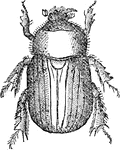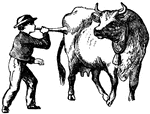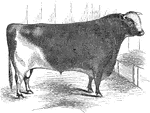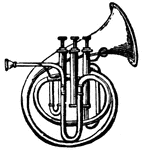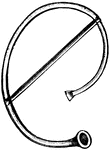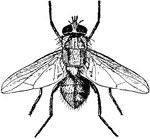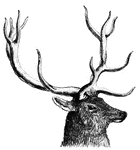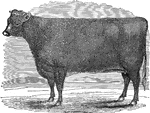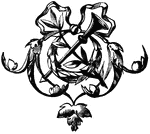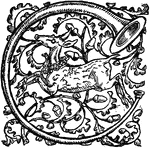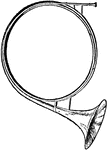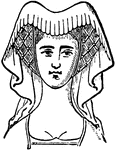
Antelope Head
"Head of antelope (Gazella granti), showing horns." —The Encyclopedia Britannica, 1903
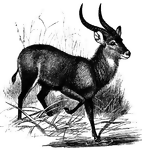
Kobus Sing-Sing Antelope
"A West-African kob antelope, Kobus sing-sing. —Whitney, 1889 This illustration shows the antelope…

Reindeer age articles, Arrow Straighteners
Arrow straighteners made from reindeer horns. Crafted during the Reindeer age.
Basset Horn
"A wood-wind instrument, not a "horn," member of the clarinet family, of which it is the tenor. The…
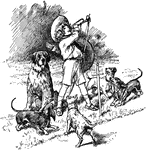
Boy Blowing Horn with Dogs by His Side
An illustration of a boy blowing a horn with dogs by his side.
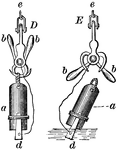
British Navy Sounding Apparatus
"To measure the depth of; fathom; try or test, as the depth of water and the quality of the ground,…

Brooke's Deep Sea Sounding Apparatus
"To measure the depth of; fathom; try or test, as the depth of water and the quality of the ground,…
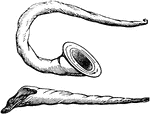
Buccina
"A kind of horn trumpet, anciently made out of a shell, the form of which is exhibited in the two specimens…

Curved buccina
"The buccina is curved for the convenience of the performer, with a very wide mouth, to diffuse…
Straight buccina
"A copy of an ancient sculpture taken from Blanchini's work, it still retains the original form of the…

Cor de Chasse
A simple harmonic horn in D, without pistons or crooks. perhaps less carefully made than the others,…
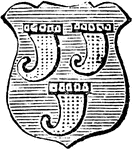
Clarion
"Azure, three clarions or. CLARION. A horn or trumpet borne in this shape in English and German coat-armour."…

Cornet
A musical instrument of the trumpet class, having a cupped mouthpiece and a conical brass tube.
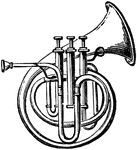
Circular Cornet
A musical instrument of the trumpet class, having a cupped mouthpiece and a conical brass tube.
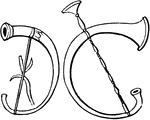
Cornu
"A wind instrument, anciently made of horn, but afterwards of brass. Like the tuba, it differed from…
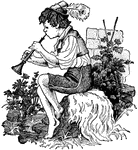
Benday Engraving
"The Benday process, so called, is the use of mechanical appliances for adding lines or stipples to…
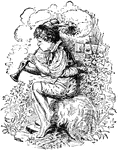
Line Engraving
"The making of line engravings follows the same general course, with the exception that no halftone…

Gar
"Two feet long, with the under jaw greatly protruded; it swims near the surface; bites at a hook; makes…

Head of Gems'bok
This illustration shows a head of a Gems'bok. A Gems'bok (Oryx Gazella) is a species of South African…
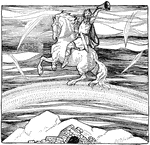
Heimdall Warns the Gods
In Norse mythology, Heimdall is the guardian of the gods. When Loki causes evil spirit to be in everyone,…
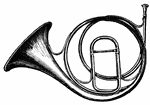
Horn
A tube bent into a spiral (for convenience in holding) comparatively narrow near the mouthpiece, and…
Basset Horn
A tenor clarinet, pitched in F, having a wider bell and greater range than a standard clarinet.
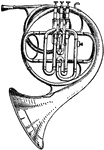
French Horn
The horn is a brass instrument consisting of about 12 feet (3.7 m) of tubing wrapped into a coil with…

Old Horn Inkstand
This old horn inkstand is made for the pocket. It is made in the shape of a horn to hold ink for writing.

Decorative Letter K with Angel Blowing Horn
A decorative letter K with an angel blowing horn underneath the letter.
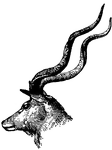
Head of Kudu
This illustration shows the head of a kudu. A kudu is a large African antelope related to the eland,…
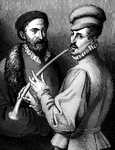
The Lesson on the Flute
This painting, by Tistian is a great example of his oil on canvas technique. It can now be found hanging…

Litmus
"This instrument was long, and curved at the end. From the similarity of form the original staff received…

Man Sticking His Head Inside of Horn
A cartoon of a man sticking his head inside of a horn, which is being held by a small person.

Elizabeth of York's Mitre Head-Dress
"Drawn from a portrait of Elizabeth of York when young, in stained glass at Little Malvern." — Encyclopedia…
